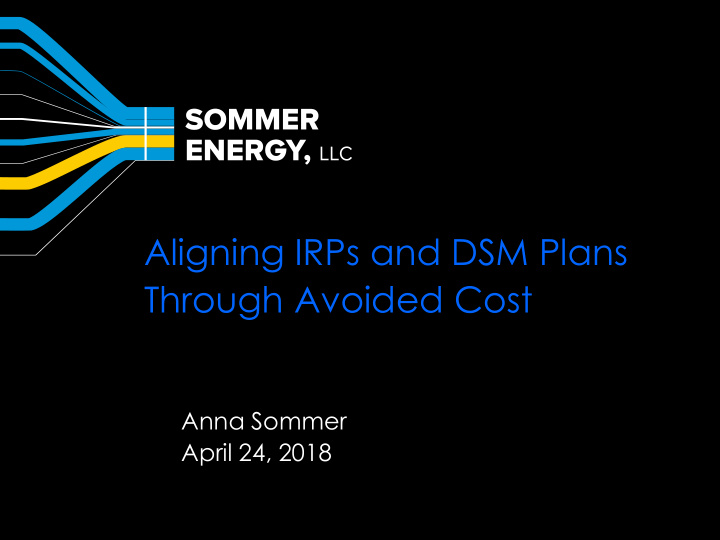



Aligning IRPs and DSM Plans Through Avoided Cost Anna Sommer April 24, 2018
About Sommer Energy • Started in 2010 • Based in rural, upstate New York • Main focus on Integrated Resource Planning (IRP) • Also do work on DSM planning, carbon capture and storage, and energy-water issues 2
Current State of IRP and DSM Plan Alignment in Indiana • Commission proposed IRP rules require, “An analysis showing that supply-side resources and demand-side resources have been evaluated on a consistent and comparable basis.” • Commission has previously ordered that an IRP that presents an optimal balance of resources “can only result from a well-developed and reasoned IRP that evaluates the appropriate balance of new supply- side and demand-side resources taking account of risks and uncertainty”. 3
Current State of IRP and DSM Plan Alignment in Indiana • Consistency is largely measured by whether the annual savings in the preferred plan of the IRP are similar to the savings in the proposed DSM plan. • In recent DSM plans, there has been some movement towards also comparing costs assumed in the IRP versus the DSM plan. • In at least one instance, an IN utility has rerun one or more IRP runs in order to demonstrate that its DSM plan was still “consistent.” 4
Current Approach to Modeling DSM in IRPs in Indiana • Contract with vendor to do a market potential study • Put results of market potential study into “bundles” group by broad end-use categories and/or cost • Model bundles as selectable resources in IRP 5
Questions Raised by Current Approach to Consistency • At what threshold is a DSM plan inconsistent with the IRP? 1 GWh difference? 10 GWh difference? 10% difference in cost? Something else? • How consistent should the IRP be with the DSM plan in other ways? E.g., measure/program types • How can perceived inconsistencies be satisfactorily rectified such that all cost-effective DSM is being leveraged? 6
Evaluating DSM and Supply-Side on an Equal Footing • Can this only be accomplished by developing similar inputs for DSM and supply-side resources? • Can this only be accomplished by making DSM “selectable”? • How do we take into account the differences between DSM and supply-side? E.g. The fact that the former is the sum of many different measures and end-uses. 7
Cost Inputs in IRP Can Vary Widely by Utility 8
Some Issues with Potential Studies • “Achievable” potential is pegged to current adoption rates of measures and not best practices • Adoption rates are assumed to only improve if a higher proportion of incremental cost is paid • Measures may be excluded • Extreme difficulty in predicting all the key characteristics of DSM over the period needed for an IRP analysis 9
An Avoided Cost Decrement Approach to EE 10
Illustrative Results 11
Benefits of an Avoided Cost Decrement Approach • Eliminates the need for potential studies in an IRP • Allows consideration of the benefits of DSM not captured in the IRP • T&D avoided costs • DRIPE • Non-Energy Benefits • Gives more accurate picture of the avoided costs of DSM than what traditionally goes into DSM avoided costs 12
Potential Criticisms of Avoided Cost Decrement Approach • Increases number of modeling runs needed (possible; depends on number of decrements modeled and modeling approach taken) • Unnecessary because avoided costs will necessarily decline as more DSM is added (no evidence of this so far and this presumes that DSM can only avoided marginal energy costs and never capacity costs) 13
Potential Criticisms of Avoided Cost Decrement Approach • Increases number of modeling runs needed (possible; depends on number of decrements modeled and modeling approach taken) • Unnecessary because avoided costs will necessarily decline as more DSM is added (no evidence of this so far and this presumes that DSM can only avoided marginal energy costs and never capacity costs) 14
Potential Criticisms of Avoided Cost Decrement Approach • Increases number of modeling runs needed (possible; depends on number of decrements modeled and modeling approach taken) • Unnecessary because avoided costs will necessarily decline as more DSM is added (no evidence of this so far and this presumes that DSM can only avoided marginal energy costs and never capacity costs) • IRP will no longer indicate how much DSM ought to be acquired making other resource acquisitions difficult (problem can be “bounded” in a number of ways including determining at what level of savings supply-side investments are avoided or delayed) 15
Recommended Additional Reading • Ten Pitfalls of Potential Studies from the Regulatory Assistance Project • The Value of Demand Reduction Induced Price Effects from the Regulatory Assistance Project • A Layer Cake of Benefits: Recognizing the Full Value of Energy Efficiency from the Regulatory Assistance Project 16
Questions? Anna Sommer anna@sommerenergy.com
Recommend
More recommend